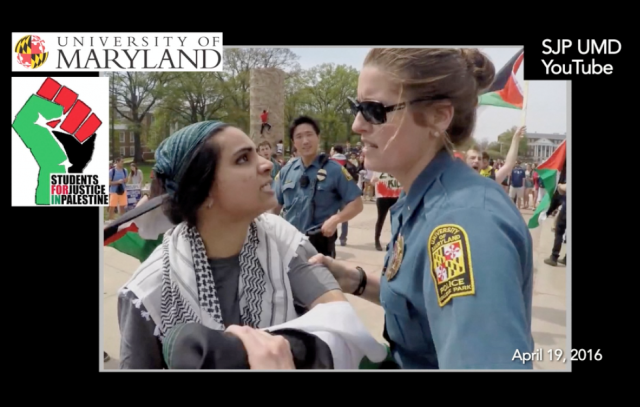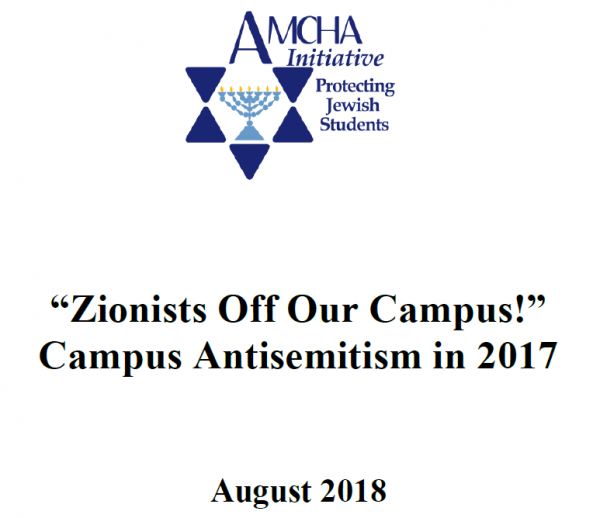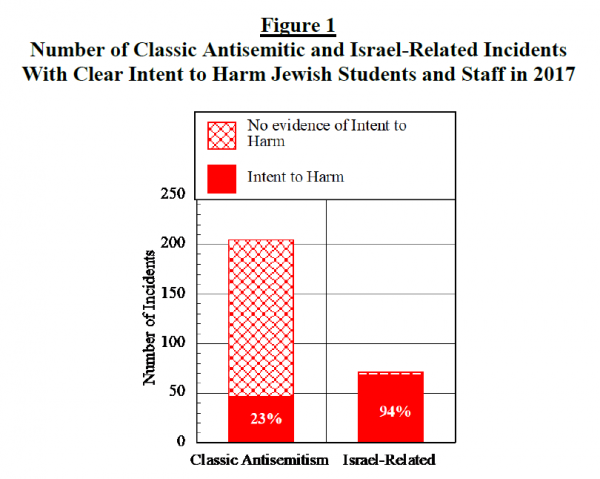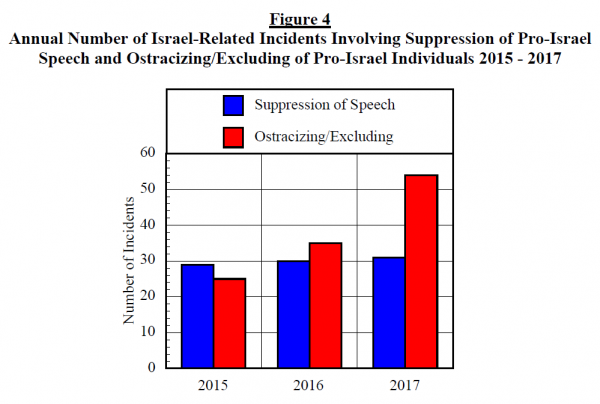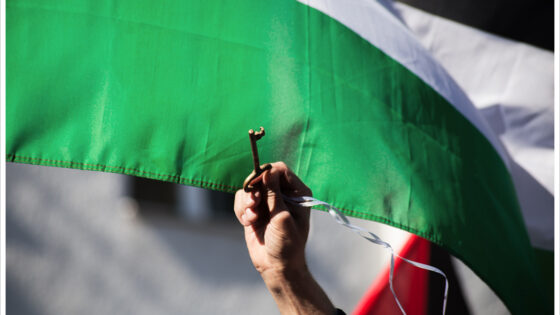For many years we’ve been documenting anti-Israel activity on U.S. university and college campuses, typically part of the Boycott, Divestment and Sanctions (BDS) movement and carried out by student groups like Students for Justice in Palestine.
In these prior posts we’ve described many instances when this Israel-related activism has crossed over the line into blatant anti-Jewish animus, including at schools as diverse as Vassar, Oberlin, and University of Illinois.
It’s important to “unmask” the SJP student chapters, including how many of them launch attacks against Jewish and Zionist students, try to shut down programming about Israel and even Jewish-themed events and guest speaker events involving non-Jews that are hosted by Hillel and other Jewish campus groups, and deliberately work to ostracize and exclude pro-Israel students from various campus activities.
Now a new AMCHA Initiative study (pdf.) released last week provides further empirical confirmation of how this Israel-related harassment and intimidation is contributing to an increasingly hostile campus environment for Jewish students—even more so than do incidents involving ‘classic’ antisemitism (i.e., instances of Nazi swastika graffiti).
This new AMCHA study is important because it highlights how BDS isn’t only directed against Israeli academic institutions but also targets individuals for harm. As the report shows, an increasingly prominent feature of BDS on American campuses is not only the promotion of the boycott of Israel, but also the boycotting of actual Jewish students and student groups.
Study finds anti-Israel incidents ‘far more likely’ to contribute to hostile campus environment https://t.co/zp19HDubXS via @JNS_org
— The AMCHA Initiative (@AMCHAInitiative) August 10, 2018
annual report on anti-Semitic activity on U.S. campuses: Israel-related anti-Semitic incidents were considerably more likely to contribute to a hostile environment for Jewish students than incidents involving classic anti-Semitism https://t.co/aR0GTVtBEO
— Shmuel Rosner (@rosnersdomain) August 8, 2018
Below I summarize AMCHA’s latest study, “Zionism Off Our Campus!” Campus Antisemitism in 2017 (all page numbers refer to the online report). A statement from AMCHA’s cofounder and director is also included below.
AMCHA’s Latest Report Explores the Intent Behind Antisemitic Activity on Campus
The AMCHA Initiative is a Santa Cruz, CA-based non-partisan and non-profit organization that monitors and combats anti-Jewish activity on hundreds of college campuses across the U.S.
In several prior posts we’ve highlighted AMCHA’s studies and reports, including one that revealed a statistically robust correlation between BDS campus activism and acts of anti-Jewish hostility and another that found a clear association between faculty support for anti-Israel academic boycotts and an increase in campus antisemitism:
- Study documents correlation between campus anti-Israelism and anti-Semitism
- New study: how anti-Israel faculty increase campus antisemitism
AMCHA’s latest 22-page study, which serves as its annual report, seeks to address a nagging shortcoming of its own previous studies on campus antisemitism and those produced by other organizations—like those issued regularly by the Anti-Defamation League, which like AMCHA also tallies incidents of anti-Jewish harassment, vandalism and assault occurring on U.S. college and university campuses (p. 3).
Specifically, in its new report, AMCHA argues that merely tallying up incidents isn’t “conclusive” because antisemitic incidents that are given equal weight in an audit may not have an equal impact on Jewish students—either individually or collectively:
For example, a small swastika drawn in a bathroom stall will most likely elicit a different emotional response than the same swastika etched into a Jewish student’s door room door, yet these incidents are equally weighted in both AMCHA’s and ADL’s tally of incidents” (p. 3).
To address this problem, AMCHA’s research team went deeper into the data to “look beyond the tallies”, examining incidents of anti-Jewish (classic) and anti-Zionist (Israel-related) harassment, vandalism, and assault in 2017 for evidence of an “intent to harm.”
Researchers differentiated between incidents that deliberately and directly intended to cause harm to Jewish students—like bullying, speech suppression, physical attacks and threats, destruction of property—and incidents where bigoted and prejudicial opinions about Jews and/or Israel were expressed, but without any evidence of an intention to harm.
In addition, AMCHA also coded for whether an incident was carried out by a person acting on his or her own or by more than one person—and whether perpetrators were affiliated with particular campus or off-campus groups.
Doing that kind of fine-tuned analysis of antisemitic incidents is especially important, according to AMCHA, because harassment and bullying that occurs by groups and multiple people—known in the sociological and psychological literature as “mobbing”—is especially harmful as it amplifies the emotional stress of its victims (p. 5).
Key Findings of AMCHA’s New Report
The new AMCHA report analyzes antisemitic activity on U.S. campuses from 2015 through the Spring semester of 2018. As noted above, data from 2017 was examined closely as well (the tally includes 205 incidents involving classic antisemitism at 125 schools in 2017, and 71 cases involving Israel at 45 schools during the same year).
Three key findings emerge from the data:
- Israel-related antisemitic incidents are considerably more likely to contribute to a hostile campus atmosphere for Jewish students than are incidents which involve ‘classic’ types of antisemitic expression.
One of the main findings revealed from the AMCHA analysis is that while classic antisemitic incidents outnumbered Israel-related incidents three to one, less than 25% of these classic antisemitic incidents—even those where genocidal expression was a common feature—demonstrated an intent to harm Jewish students and groups on campus, while a whopping 94% of the Israel-related incidents did exhibit an intent to cause harm (pp. 6, 9).
[AMCHA annual report | August 2018]
In addition, these Israel-related incidents (with intent to harm) were 6.5 times more likely to have multiple perpetrators and these offenders were 7 times more likely to be affiliated with specific groups than in the case of the classic antisemitic incidents, where perpetrators typically acted alone.
Swastika graffiti and neo-Nazi flyers distributed on campuses are horrible and there’s little doubt that Jewish students on a university or college where this happens will be deeply affected. But AMCHA is right to point out that these incidents are very different than the kind of personalized peer-on-peer harassment perpetrated these days by anti-Israel student activists and that it’s these incidents that will tend to take an even greater toll on the campus Jewish community.
- Israel-related incidents are becoming “significantly more flagrant” and are increasingly characterized by a shift from a focus on anti-Israel boycotts and divestment campaigns to actual boycotts of Jewish students and student groups.
A key finding in the AMCHA report is that activism geared to suppressing speech and to ostracizing and marginalizing Zionist students from campus life are now the most common forms of Israel-related antisemitic incidents (p. 6):
- 44% of Israel-related incidents involved behavior designed to silence Jewish and Zionist students, including disrupting or defacing Israel-related events, displays, and trips;
- 76% of Israel-related incidents involved behavior that personally targeted Jewish and Zionist students or groups, denigrating and demonizing them so as to exclude them from campus activities.
Incidents involving attempts to ostracize and marginalize pro-Israel students from campus life more than doubled during the nearly three years under review (2015-2018). Incidents including calls to boycott any and all interaction with Zionist students or groups, and even open calls to expel these students or groups (like Hillel) from campus, rose from 3 such incidents in 2015 to 14 in 2017 and an astonishing 18 in the first half of 2018 (p. 7).
[AMCHA annual report | August 2018]
So the study makes it clear that classic antisemitism—genocidal expression like swastika graffiti and statements of a desire to murder and annihilate Jews—continues to make up the vast majority of incidents on campus and is rising exponentially (p. 11).
But it’s the Israel-related incidents that are much more brazen and are being perpetrated by students (and sometimes even faculty) who are banding together in groups and are often supported by off-campus organizations too (pp. 14-16). This key finding of the AMCHA report is one that other studies have also reported, New Report: Anti-Israel activism on campus more “aggressive, sophisticated”.
- College administrators are “less likely” to adequately address antisemitic forms of anti-Israel activism on campus than they are classic antisemitic incidents.
The AMCHA report notes that while acts of Israel-related antisemitism are becoming a larger contributor to the hostile campus atmosphere for Jews and Zionists, university administrators generally don’t properly address such incidents—even though they are largely sympathetic and usually respond appropriately to incidents involving classic antisemitism (e.g., swastika graffiti).
AMCHA researchers suggest a reason for that, which seems entirely plausible:
university administrators rarely recognize anti-Zionist harassment as a form of unlawful discrimination, because they see it as motivated by political considerations rather than religious or ethnic ones” (p. 17).
In the report’s concluding section, a number of “immediate steps” that university administrators “can and should take now” are discussed, including issuing statements and amending university policies so as to ensure that all students will be equally protected from intolerant behavior and harassment and instituting educational programs to encourage freedom of speech and assembly (pp. 17-18).
Given the evolving threats that Jewish and pro-Israel students will face in the upcoming academic year, these suggestions make a whole lot of common sense.
Specific Examples of Classic Antisemitic Incidents on Campuses and Israel-Related Incidents Flagged in the New AMCHA Report
AMCHA’s new report includes a sampling of over a dozen recent Israel-related incidents that have occurred on campuses across the country, including at large and small colleges and private and public universities. This suggests that while most American campuses aren’t hotbeds of antisemitism or rife with anti-Israelism, no U.S. campus is really immune from this hate.
Here are some of the incidents coded in the AMCHA study as instances of classic antisemitic expression with an intent to harm:
- At Beloit College, an antisemitic note slipped under a Jewish student’s dorm room door contained the message: “Kike, you should be gassed for what you say & do on this campus. Be worried C**T.” A large swastika was drawn alongside the note’s text.
- A Jewish student at the University of Minnesota found an antisemitic message on a whiteboard inside his dorm room. The message read “Nazi’s Rule,” and was accompanied by a swastika and a drawing of a concentration camp.
- About 100 leaflets with hand-drawn swastikas were found strewn across the lawn of the campus Chabad Jewish Student Center at Virginia Polytechnic Institute. The incident came a day after the center announced it would bring Holocaust survivor Rabbi Nissen Mangel to campus for an event to honor professor Liviu Librescu, a Holocaust survivor who was killed in the Virginia Tech massacre in 2007 when he helped block his classroom door so students could escape.
Here are some of the examples of Israel-related incidents that according to AMCHA’s research team also exhibit a clear motivation on the part of the perpetrators to cause harm to Jewish students or student groups:
- At University of Houston, protesters disrupted a student group’s event with chants of “Zionists off our campus…Zionists off our Campus…Free, Free, Free Palestine,” and one protester additionally shouted, “F*** Zionists, F*** all you Zionists!” The protesters continued their demonstration outside the event hall, loudly chanting, “Whose campus? Our campus!…Racists off our campus, Zionists off our campus, Islamophobes off our campus! Fists up, fight back!”
- During a Hillel event to celebrate Israeli Independence Day in the campus square at the University of California Santa Cruz, a protest led by the African/Black Student Alliance filled the square and purposefully blocked Hillel’s tables from being accessed for over an hour. Jewish students were, on three separate occasions, subjected to protesters yelling, “Free Palestine” and “F*** Jewish Slugs.” One of Hillel’s Israeli flags was also torn down.
- At the University of Texas Austin, Jewish students attempting to table to raise funds for an Israeli non-profit called “Save a Child’s Heart” were impeded when two other student groups moved their tables to flank them, began yelling, chanting and waving a flag over the Jewish students’ heads, and drowned out their calls for donations. When the Jewish students relocated to another part of the campus square, the disruptors followed them and continued to impede their efforts for two days.
- At the University of Washington, an educational display promoting peace that was set up by a pro-Israel student group was vandalized when an individual ran up to the display, yelled “F*** you guys” at the Jewish students who had set up the display, ripped one of the display’s posters and then ran off.
- At Pomona College, an SJP member posted a photo on Snapchat and Twitter of the Claremont Progressive Jewish Alliance student president with the caption ‘Her name is Kate ______ and she is a proud racist.’ The post was favorited and retweeted by SJP members.
- At St. Olaf College, Oles for Justice in Palestine created a petition asking the College to remove an alumnus from the Advisory Board of the Institute for Freedom and Community at St. Olaf College, claiming, “Arne Christenson is a key member of the Apartheid lobby and an outspoken Christian Zionist. He ought to have no position at any institute for ‘freedom’ or ‘community’ and certainly no position at St. Olaf.”
Jewish Student Testimonials From 2017 Flagged in the New AMCHA Report
There’s a lot of information, statistics and data packed into this 22-page report, but the bottom line is that the vast majority of anti-Israel campus activities are no longer just intended to cause harm to Israel—increasingly they’re also meant to “harm pro-Israel members of the campus community” (pp. 5, 17).
New report by watchdog @AMCHAInitiative shows #Antisemitism soaring on college campuses. One Jewish student received note under door stating: "K**e you should be gassed…Be worried C**T" with large #swastika drawn alongside. https://t.co/jUzvADk2rN
— Lea Speyer (@LeaRSpeyer) August 9, 2018
That this anti-Zionist harassment, often accompanied by vandalism, assault and threats of physical violence, “personally and directly” targets Jewish students for “intentional harm” is clear from the sampling of 2017 testimonials from Jewish students.
The testimonials are included as a 3-page Appendix (pp. 19-21) in the new report (there are also many more student remarks from recent years, and a number from 2018 too, on AMCHA’s “Student Voices” page on its website).
These 17 testimonials will break your heart.
Here are just a few, but all of them are worth reading to get a good sense of the degree of hostility that Jews and Zionist students face on some American campuses today and how much they’re being harassed, silenced and intimidated:
- “There’s a lot of little stuff that occurs on campus. For every swastika, there’s a million little conversations that go on that are much more harmful than that. Everyone can get behind, ‘Alright, there’s a swastika. That’s ridiculous, that’s not OK’. But for the little conversations that are more political in nature people just assume that it’s OK to say, ‘Well, you’re a Zionist, so I don’t like you,’ and that’s part of our culture.” (College of William and Mary)
- “When someone wrote ‘No n*****s, whites only’ on a Black Lives Matter flyer, the Duke community held a march where over a hundred students marched and rallied in support. They did the same thing when someone wrote a homophobic slur in the dorms. When someone wrote anti-Semitic comments on a Duke Friends of Israel flyer, there was no march, rally, or campus outrage.” (Duke University)
- “During the weekend of Sept. 16, a giant swastika was constructed in a classroom across from my office on campus. Given my Jewish appearance, the mezuzah on the doorpost of my office, and the small menorah I have on the window sill facing the street — the location chosen for the swastika was not a coincidence. It was not a prank. It was directed at me personally (yet not solely at me). I saw it, and it petrified me.” (Purdue University)
- “They specifically called out Zionists and made clear we were not welcome on this campus … they made it clear I and others like me are the targets. Hillel, IlliniPAC, and all Zionists were called out directly. We were compared to the KKK, to violent fascists and accused of perpetuating white supremacy all because we believe that the Jewish people have a right to self-determination.” (University of Illinois Urbana-Champaign)
- “Someone in a green hoodie and black backpack came past us and tore down our Pro-Israel, Pro-Palestine, Pro-Peace poster and ran away. We have been tabling all week to promote dialogue, negotiations, and cooperation as the best path toward a peaceful solution to the Israeli Palestinian conflict. This man did not stop to talk to us and ask us what we were doing or what we believed in. He just came behind us, said ‘F*** you guys’ and tore down our sign.” (University of Washington)
- “As a Jewish student at UW, I was deeply hurt on April 12 [during Passover], when myself and 12 percent of the student body (approximately 5,000 students) were excluded from the democratic process.” (University of Wisconsin Madison)
Statement from AMCHA’s Tammi Rossman-Benjamin
I reached out to AMCHA’s cofounder and director, Tammi Rossman-Benjamin, to find out more about how her organization hopes that its latest report will be used to address BDS harassment on campus in order to better protect the civil rights and safety of Jewish students.
Rossman-Benjamin sent me these remarks via email:
Those of us who have been studying and combating campus anti-Semitism know that numbers can only reveal so much. Therefore, we decided to go deeper to examine if certain types of incidents are causing more damage than others. And we discovered that not all bigoted incidents are created equal. Certain types carry significantly more weight and have far more of a lasting impact. In fact, while incidents of classic anti-Semitism far outnumbered Israel-related anti-Semitism in 2017, it was the significantly more brazen Israel-related incidents, with their calls to boycott, ostracize, exclude and even expel pro-Israel students, often times committed in groups and targeting individual students and student leaders by name, that were creating the most hostility for Jewish students. This is a huge shift in how people have understood the surge in campus anti-Semitism up until now, and that is helpful. It provides those of us in the Jewish community who are fighting campus anti-Semitism with valuable information on where to focus our efforts and resources. Sadly, though, while these types of incidents cause the most harm, they are the least likely to be addressed by university leaders who excuse them as politics. We hope this information will help change that since harassment is harassment, regardless of its motivation. The deleterious effects of pervasive anti-Zionist harassment—of being targeted, bullied, shunned and hated—are the same, and must be addressed as such, fairly and equitably. It’s time university leaders open their eyes and commit to protect all students on campus, not just some.”
Conclusion
On many of America’s universities and colleges today, Jewish and Zionist students are being ostracized, intimidated, and even physically assaulted based on their identification with the Jewish state.
The AMCHA Initiative’s new study makes clear that on scores of campuses this harassing conduct by the anti-Israel movement and its campus activists is so severe and persistent that it’s interfering with the ability of pro-Israel students to benefit from the services, activities, and opportunities offered at their schools.
Basically, Jews are being told that they must disavow a huge chunk of their identity before they can participate in campus life—especially when it comes to progressive social justice activities.
In fact, this uptick in ostracism of Jewish students from progressive groups (see earlier coverage of this disturbing trend here, here, and here) is a clear indication that BDS aims to silence not only Israeli voices on campus but anyone who feels connected to the Jewish state and who views Zionism as “intimately or essentially related” to their Jewish self-conception.
Bottom line: AMCHA’s latest study shows how anti-Israel activism on some U.S. campuses is managing to stigmatize and intimidate Jewish students and utterly denigrate their Jewish identities. For other media reports of this groundbreaking study see, for example, here, here, here, and here.
[Feature Image: screenshot of arrest of Students for Justice in Palestinestudent at the University of Maryland, YouTube]
Miriam F. Elman is an Associate Professor of Political Science and the Inaugural Robert D. McClure Professor of Teaching Excellence at the Maxwell School of Citizenship & Public Affairs, Syracuse University. She is the editor of five books and the author of over 65 journal articles, book chapters, and government reports on topics related to international and national security, religion and politics, and the Israeli-Palestinian conflict. She also frequently speaks and writes on the Boycott, Divestment, and Sanctions (BDS) anti-Israel movement. Follow her onFacebook and Twitter @MiriamElman


